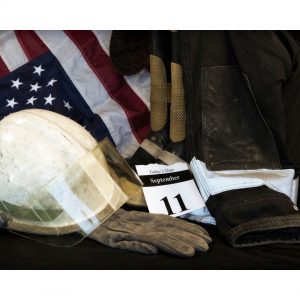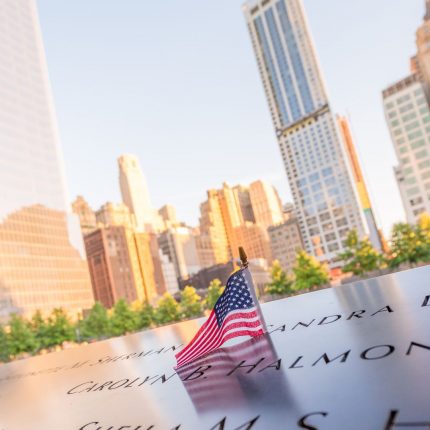On September 11, 2001, the world as we knew it changed. That morning, four planes were hijacked by members of an Islamic extremist group known as al Queda, and those planes were used to carry out suicide attacks against targets on United States soil. Two planes flew into the World Trade Center towers in New York City, one flew into the Pentagon outside Washington, D.C., and the last plane crashed in a rural field in western Pennsylvania. Almost 3,000 people (2,996 to be exact, including the 19 hijackers) lost their lives in these terrorist attacks on this fateful day.
I’m sure those of us who experienced the 9/11 attacks will never forget where we were, what was going on, and how we felt in that moment and in the days to come. Because this crucial historical event happened in recent years, we have the unique opportunity to discuss it with our children from a personal perspective. Just as our grandparents or great-grandparents may have been able to tell us what it was like when the Japanese bombed Pearl Harbor on December 7, 1941, or our parents could speak to the climate of unrest during the Civil Rights Movement and the Vietnam War during the 1960s, history looks entirely different when told by someone who personally experienced the events versus just reading about it in a book.
Discussing the Events
I feel this is a good time to interject a quick caveat: One thing to keep in mind when discussing the events of September 11 with your children is to keep it age-appropriate. If you have young ones, tell them what happened that day in broad terms. Just because we may have been traumatized as children when the attacks took place doesn’t mean we have to traumatize our children by telling them every nitty-gritty detail. Just something to think about.
So what did happen that day? We know the particular planes that were hijacked, the timing of the attack, and the targets that were chosen were all choreographed in an effort to maximize casualties. The four planes were all headed to California, so their massive fuel tanks were full for the journey, igniting a larger explosion. Many had already arrived or were arriving at work for the day, and there is never a shortage of people in New York City and Washington, D.C. With these high-profile targets, it was also guaranteed that news would quickly spread, and the news was sure to bring along fear to the hearts and minds of those who heard it.
timing of the attack, and the targets that were chosen were all choreographed in an effort to maximize casualties. The four planes were all headed to California, so their massive fuel tanks were full for the journey, igniting a larger explosion. Many had already arrived or were arriving at work for the day, and there is never a shortage of people in New York City and Washington, D.C. With these high-profile targets, it was also guaranteed that news would quickly spread, and the news was sure to bring along fear to the hearts and minds of those who heard it.
We know that recounting and teaching about these attacks will produce many questions from our children. Who would do that? Why would they do that? Discussing terrorism is always a touchy subject, but it is, unfortunately, necessary in the world in which we live.
But while we must answer these questions and more, we also get to tell our children about the bravery of the men and women who ran into these buildings to save as many as possible, the courage of those aboard United Flight 93 who overpowered the terrorists and brought the plane down in an empty field instead of its intended target, and the resilience of the American people to come together on that day and in the days ahead.
Marking the Anniversary
There are many ways to mark the anniversary of September 11, now known as Patriot Day, in your homeschool. Here are a few suggestions:
- Visit the website dedicated to the 9/11 Memorial and Museum in New York City. They even offer free lesson plans for those in grades 3-12. (If you’re looking for something to show and/or explain to younger children, check out Scholastic or PBS for their resources.)
- Take a trip to the library to find age-appropriate books on the history of 9/11 to read with your children.
- View photos, news stories, YouTube videos, or documentaries with older children. You could also listen to music! Several artists (Darryl Worley, Alan Jackson, and others) released songs commemorating September 11.
- Talk about how the events of 9/11 affect us today – strict restrictions on airplane carry-ons and airplane safety, the passing of the Patriot Act, the creation of the Department of Homeland Security, etc.
- Focus on the good! Learn about Todd Beamer, Sandy Bradshaw, Stephen Sillers, Sirius, Welles Crowther, and the many other heroes of September 11.
- Talk about our Flag and how it became a symbol of unity and the fighting spirit of the American people in the days and months following 9/11. You can even take some time to do a flag or other patriotic craft with your children.
- Visit your local police or fire station with homemade cards or treats to show your appreciation for all they do in their never-ending pursuit to keep us safe.
These subjects are often difficult to broach with our children because we would love to keep them sheltered from the evils of the world. What a privilege it is to be able to homeschool, have open and honest discussions with our little and not-so-little ones, and watch them form their worldview that will shape their future!
Additional Homeschool Resources
How to Teach Homeschool History
Storytelling as a Way to Teach History – PODCAST
Naomi White
Naomi White graduated with her B.S. in Christian Elementary Education and went on to earn her Early Childhood Education certification. She has taught preschool and elementary school in both Christian and public schools. She loves to read and write, is a pastor’s wife and stay-at-home mom, and is eagerly awaiting the day her son is old enough for them to start their own homeschool journey. Originally a Georgia girl, Naomi currently lives in the beautiful mountains of North Carolina with her family.
Latest Posts

This post is sponsored by Little Monsters Universe. I'm Tina Salmanowitz, an advocate for homeschooling and science education. With over a decade of experience as a science educator (in class…
Read more >
This post is sponsored by Time4Learning. Before the pandemic, it was business as usual for Boca Raton resident Nikki Warris. Her two daughters, 5-year-old Natalie and 8-year-old Lexi were…
Read more >
Are you a "Green Goddess" or a "Trash it Tom"? Recycling is an important thing we can all do to help preserve our environment. No doubt, you’ve heard the phrase “Reduce, Reuse, Recycle,”…
Read more >


